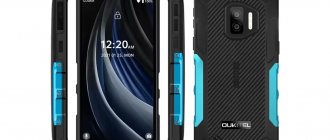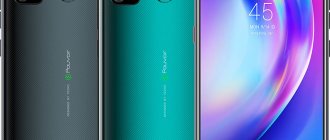Smartphones have made the process of photography convenient and accessible to everyone. But art connoisseurs understand that only good cameras can take truly high-quality photographs.
Nikon cameras
Canon cameras
Sony cameras
The best video cameras
Action cameras
[Hide]
The best DSLR cameras
This category includes models that are technically the most complex. They are equipped with powerful optics, multilayer matrices and ultra-fast processors. The latest DSLR models are created with an audience of professional photographers, social media enthusiasts and bloggers in mind.
1
Leica S3
Expensive and modern
DSLR cameras aren't updated much these days, but Leica has a new medium format camera. It is prohibitively expensive, but it has no competitors.
Find out the price
Pros:
- compact magnesium alloy body;
- traditionally impeccable Leica lenses;
- high performance;
- Large and convenient optical viewfinder.
Minuses:
- autofocus works only at one point;
- The camera is unreasonably expensive.
For a medium format DSLR, last year's update to the Leica S3 is surprisingly compact and lightweight. Of course, we had to pay for this in ergonomics.
The body itself still feels comfortable in the hands, but the number of physical controls is kept to a minimum - most settings must be made through the touch screen. But two additional mini-displays at the top do a good job of relieving the on-screen menu.
The new model was equipped with a 64 megapixel CMOS matrix. It is great for working in difficult lighting conditions, and even at high ISO it does not produce much noise. The camera can shoot in small bursts (3 frames each), since its RAW buffer is small. But for a DSLR this is still a plus.
2
Nikon D5600
The most affordable and popular DSLR
Last year, this not new camera broke sales records. Nikon plans to discontinue it, but does not yet offer similar entry-level DSLRs.
Find out the price
Pros:
- screen with a rotating mechanism;
- many shooting modes, including selfie;
- presence of a stereo microphone;
- light weight - 465 g.
Minuses:
- buttons are too small to view photos;
- Slow operation in Live View mode.
The device is suitable for travel photography and creating content for a blog. By transferring pictures to your smartphone using Bluetooth, you can immediately publish them on social networks.
One of the most popular models from Nikon amazes with its excellent technical characteristics: 39-point autofocus system, LCD touch screen, ISO up to 25,000.
The device is equipped with a removable AF-P DX lens with optical stabilization. The noise reduction system eliminates blur even when shooting at night. The camera is equipped with Bluetooth and Wi-Fi modules for connecting with other gadgets.
3
Canon EOS 90D Body
Good for dynamic shooting
The camera will take its rightful place in the equipment of a sports reporter or travel blogger. It will also be useful for professionals filming in the studio.
Find out the price
Pros:
- touch focus control;
- high continuous shooting speed - 10 frames per second;
- Wi-Fi and Bluetooth connection;
- There are ports for headphones and microphone.
Minuses:
- lack of a USB Type-C port;
- video size restrictions.
Launching in August 2022, the camera is powered by the Digic 8 processor, which not only delivers fast frame processing speeds but also enables lens optimization.
The 32.5 megapixel matrix provides excellent detail when taking photographs in complex formats, including Live View.
The tilt screen makes it easy to take photos from different angles. The optical viewfinder helps photograph moving scenes: sports and holidays, children, animals and birds.
4
Pentax K-1 Mark II
Universal in its own way
The Mark II camera can be recommended to a professional photographer working in various genres - from landscape photography to studio portraits.
Find out the price
Pros:
- shooting in RAW format;
- ability to record files on 2 memory cards;
- built-in GPS;
- protection from dust and moisture.
Minuses:
- rapid battery drain;
- lack of touch controls.
The main difference between the camera is the electronic mechanism, consisting of a 35 megapixel matrix, a processor and a special accelerating chip. They provide fast image processing, automatically cutting out digital noise and moire.
Autofocus based on 33 sensors and in-camera stabilization guarantee excellent image clarity. The Pentax K-1 Mark II lags behind its competitors in display resolution (1.04 million pixels), but surpasses them in ISO - 100-819200.
Criterias of choice
Expensive equipment intended for professionals has high resolution, the possibility of both automatic and full manual control, a shock-resistant body with reliable components and fast shutter speed.
Professional equipment provides absolute freedom of creativity. But to achieve the desired results, it is necessary to take into account important criteria, because sports and studio filming may require different models, because some are designed for maximum speed, others for detail.
Before choosing a camera, you need to pay attention to several basic parameters:
- Functional;
- Speed of operation, quick shooting function;
- Equipped with a rotating display;
- Autofocus accuracy;
- Ergonomic, resistance to mechanical damage.
Most modern devices are simple and easy to use. Manufacturers provide them with many buttons that provide quick access to the most popular and important settings and modes. The speed and quality of the final product directly depends on the functionality. In addition, by purchasing professional equipment, the owner provides himself with a resource for professional growth and development.
The best mirrorless cameras
This type of camera offers many of the same features as more expensive DSLR cameras. They are also equipped with fast processors and powerful matrices, so they create bright, high-resolution images. And due to their light weight and small size, they are more convenient to use than DSLRs.
1
Panasonic Lumix GH5 II
For videographers
Panasonic continues to improve its Lumix GH5 cameras. And although it has not yet introduced any serious changes, the second revision of the “fives” has practically nothing to reproach.
Find out the price
Pros:
- fast autofocus, powered by AI;
- clear stabilization that adapts to different lenses;
- H265 codec support;
- the ability to conduct a mobile stream;
- plenty of settings
- dust and moisture protection of the case.
Minuses:
- Noise appears in video at ISO 3200 and higher.
A hybrid camera with extensive video capabilities is still considered an amateur camera, but the quality of the material shot with it is quite professional. The model supports Open Gate - a mode in which the entire area of the matrix is used.
But in the new Lumix, the dynamic range was expanded by a quarter, and an anti-reflective coating was applied to the sensor, thereby reducing the number of artifacts in the pictures (especially in the dark). Software color profiles have also been added.
The most important thing is that it now uses the latest Venus processor, thanks to which 10-bit 4K shooting at a speed of 50-60 frames per second has become available.
2
Leica SL2 Body
Impeccable workmanship
The camera with premium characteristics is aimed at use in professional photo studios and media editorial offices.
Find out the price
Pros:
- simple control panel;
- the ability to use UHS-II memory cards;
- headphone and microphone jacks;
- Availability of Wi-Fi and Bluetooth connections.
Minuses:
- the display is not rotatable;
- video time limit.
The model features a durable aluminum body covered in leather. The camera offers many technical features: an electronic viewfinder with an OLED display, continuous autofocus at 20 frames per second, and 5K video recording.
A 5-axis optical stabilizer eliminates blurring due to camera shake. Files are recorded in popular JPEG and DNG RAW formats. This model is not the newest, and now it can already be bought for quite reasonable money.
3
Nikon Z6
Full-frame camera with Z-mount
The camera is suitable for people starting to master professional photography. It is good for family photography and holiday sessions.
Find out the price
Pros:
- convenient control;
- rich color rendition;
- many additional functions;
- bright LCD display even in sunlight;
- backlight.
Minuses:
- only one memory card slot;
- Uncertain autofocus in the dark.
The model is a continuation of the new line of mirrorless cameras launched in 2022. It uses a mount with a diameter of 55 mm, providing more light to the sensor.
The matrix features back-illumination and a 24.5 megapixel resolution, which is ideal for creating bright, detailed photographs. In addition, it has its own 5-axis stabilization system. The Expeed 6 processor works across all ISO ranges, automatically eliminating digital noise.
In accordance with modern requirements, the camera can record 4K video, supports fast XQD memory cards, and works stably via Bluetooth and Wi-Fi wireless communications. Well, the electronic control ring on the lens with the new mount turned out to be very convenient.
4
Sony Alpha ILCE-7M3I
Optimal balance of price and functionality
Compactness and high battery life make the Sony Alpha 7 III an excellent tool for the tech-savvy traveler, journalist and blogger.
Find out the price
Pros:
- capacious battery (enough for 650 shots);
- advanced autofocus with 693 points;
- many shooting modes;
- small sizes;
- matrix with back illumination.
Minuses:
- complex menu;
- poor protection against water.
The model went on sale in 2022, and soon received the nickname “DSLR killer.” The camera really has many strong points: a 24 megapixel matrix with back illumination, a BIONZ X processor and 7 advanced ISO modes. Convenience of working with the camera is ensured by touch control and the presence of two shutters: mechanical and silent electronic.
Thanks to these features, the device takes photographs at a speed of 10 frames per second. The image stabilizer smoothes out lens vibrations along 5 axes. All focusing functions are well implemented: by eye, continuous tracking of a moving object, phase focusing over almost the entire area. A buffer of 70 RAW frames allows you to make large series. Ideal for dynamic scenes.
5
Fujifilm X-T4
Professional equipment
The camera performs best in burst shooting, which is why it is used by professional reporters. Convenient controls and a variety of functions will also appeal to novice photographers.
Find out the price
Pros:
- realistic color rendering;
- presence of 2 slots for memory cards;
- connections via Wi-Fi and Bluetooth;
- ability to record video in 4K;
- matrix stabilization;
- increased battery capacity (up to 600 shots).
Minuses:
- limited RAW buffer volume.
In general, this model is a more advanced version of the X-T3 that recently appeared on the market. The camera is equipped with an X-Trans CMOS 4 matrix, which processes images 1.5 times faster. The quad-core X-Processor 4 processor also provides high speed.
The electronic viewfinder and LCD touch screen make shooting easy. Due to the lack of optical stabilization, the camera is somewhat inferior to its competitors, but this deficiency is made up for by excellent 425-point autofocus.
But compared to the semi-professional “troika”, it has its own interesting features. This includes built-in 5-axis matrix stabilization and increased burst speed to 15 frames per second. There is also a function for converting images F-Log View Assist for preview on the screen.
6
Hasselblad X1D II 50C Body
Better color reproduction
The camera is aimed at “pure” photographers who are not interested in creating videos. The model is recommended for creating portraits, conducting studio and street photo shoots.
Find out the price
Pros:
- aluminium case;
- ease of use;
- built-in GPS;
- charging from a laptop and power supply;
- Possibility of control from mobile gadgets.
Minuses:
- no video and sound recording;
- Slow shutter response.
The camera is positioned as a medium format camera. It features an OLED EVF display with a resolution of 3.69 million pixels. Proprietary Natural Color Solution technology improves color reproduction right during the shooting process.
The 117-point autofocus isn't the best in this category, but it does allow for continuous shooting at 2.7 fps. The camera supports UHS-II SD memory cards, on which you can save JPG and RAW files.
The device itself captivates with its ergonomics. The case looks unusual, but fits very comfortably in the hand. Mechanical controls are conveniently located and easy to master. All this is complemented by a cool screen with a large reserve of brightness and an oleophobic coating.
Canon EOS 6D Mark II
The Canon EOS 6D Mark II is a DSLR camera that has a 27.1 megapixel matrix and a three-inch rotating touch screen.
It also includes an image stabilizer. This is a convenient and ergonomic camera with a full frame range. The model includes a rotating screen and an electronic level function. The latter helps to set the horizon with greater accuracy at night. Thanks to electronic stabilization, you can easily create stunning videos.
And to make it even more convenient to use the equipment, you can connect the device to your mobile phone via Wi-Fi and control it.
Advantages:
- matrix cleaning;
- electronic stabilization during video shooting;
- protecting the body from debris;
- Can be attached to a tripod.
Flaws:
- high price;
- No lens included;
- one section for a memory card.
The best compact cameras
The most “democratic” category of photographic equipment, designed for non-professional photographers. Compact cameras with their small dimensions and simple settings are convenient for filming at home and traveling.
However, the latest top compacts with fast processors and high light sensitivity are quite suitable for professional use.
1
Ricoh GR IIIx
Small camera for street photographers
Updated this year, the device is so small that it fits in your pocket. It will appeal to those who often take photographs while traveling and in everyday life.
Find out the price
Pros:
- excellent build quality;
- touch focus;
- matrix stabilization;
- low digital noise;
- ability to transfer files via Wi-Fi.
Minuses:
- lack of zoom;
- The price is high for a compact.
This miniature camera is only slightly larger than a smartphone. But it has much wider possibilities for photography: reliable stabilization, autofocus with backlight, and high ISO modes.
A user-friendly interface helps you set the settings to suit the photographer's style. There are two types of flash - internal and external. Well, the 24.2 megapixel APS-C matrix looks advantageous.
The model differs from its predecessor - the “troika” without the x-prefix - with a new processor. However, this did not expand the video capabilities of the camera, although it did make the hardware settings work better and faster.
2
Olympus Tough TG-6
Rugged compact for underwater photography
The camera is designed to work in extreme conditions: on hikes, on vacation, during river rafting. It is also suitable for nature photographers photographing animals, fish and insects.
Find out the price
Pros:
- matrix backlight;
- macro system, plus 5 underwater shooting modes;
- possibility of wireless control;
- adding date and time to photos;
- secure execution.
Minuses:
- the display is not touch-sensitive;
- only 3 aperture values.
The new product continues the Tough line, the very name of which means “severe”. The camera is protected from shock, frost down to -10 ° C and immersion in water up to 15 m.
The back-illuminated sensor and TruePic VIII processor allow you to shoot in complex modes, including underwater. The 4x zoom capabilities are doubled with the built-in teleconverter.
The F/2.02 aperture ensures excellent clarity and brightness of photos. But the most interesting thing about this compact is the ability to record 4K video at 30 frames per second.
3
Sony Cyber-shot DSC-RX100 VII
The fastest-firing camera
The next update of popular compacts from Sony has become even smaller in size, but has significantly increased functionality.
Find out the price
Pros:
- 4K video recording;
- face and eye autofocus;
- back illumination of the matrix;
- high burst speed;
- charging from power bank.
Minuses:
- no protection against moisture.
The seventh version of Cyber-shot cameras has become even more advanced. First of all, video shooters will be pleased with the absence of a software time limit for 4K recording. The telescopic Zeiss lens and the control ring on it with reassignable functions remained in place.
Inside there is a 20.1 megapixel CMOS matrix with back illumination. I'm pleased with the incredible shooting speed - up to 90 frames per second. With tracking autofocus, the figure is much more modest (20 fps), but still impressive. Another feature of the model is the viewfinder that extends out of the body.
4
Canon PowerShot SX70HS
Large zoom
The manufacturer recommends this model to people who are starting to master the art of photography. The camera performs well in landscape and family photography.
Find out the price
Pros:
- ergonomics;
- many useful functions;
- saving files in RAW and JPG formats;
- ability to shoot video in 4K.
Minuses:
- mediocre image quality in low light;
- The display is not touch sensitive.
Actually, this is not a purebred compact, but a bridge camera that fills the gap between compact and mirrorless cameras. But this format made it possible to obtain an impressive zoom in a relatively small body and without an abundance of interchangeable lenses.
The Canon PowerShot boasts a powerful 65x zoom lens. The Digic 8 processor provides fast image processing, which is important for continuous shooting. Yes, the ISO performance here is quite low - from 100 to 3200, but the presence of optical stabilization improves the quality of the pictures.
Wi-Fi and Bluetooth connections allow you to wirelessly transfer files and control the camera from iOS and Android gadgets. In addition, there is a Hybrid Auto mode with different visual effects, which records a short video when taking photographs, and then makes an original digest magazine out of the material.
Let's summarize
After studying all the models, the question remains how to really choose your camera. To make the task easier for a beginner in the world of photography, below is a table that clearly shows how to choose a camera for an amateur.
| P/n | Subject to shoot | The required device |
| 1 | I take a lot of photos for myself, which are mostly posted on social networks. | A good smartphone or an inexpensive point-and-shoot camera. |
| 2 | I would like to always have a camera at hand, but at the same time get high-quality pictures in nature. | An expensive “compact” or an entry-level “mirrorless” camera. They are often comparable in price. |
| 3 | Looking for a family chronograph that can take great photos indoors. | A DSLR or mirrorless camera, complemented by an external flash and a portrait lens. |
| 4 | You need to take high-quality photos during long trips. | In this case, only a “DSLR” with an impressive supply of lenses. |
In conclusion, I would just like to note that the best cameras for amateurs are not a separate class that exists on its own. Rather, these are some selection criteria that have common features. You can find them for every type of camera. You just need to decide what it is actually needed for.
How to choose a camera
During the pandemic, the camera market not only sank, but fell to its knees: in 2022, according to Techno System Research, camera sales decreased by 40%. However, their choice has not become smaller - popular models continue to be produced, and even several new devices have appeared.
So even now there are quite a lot of different devices on the market. All of them are divided into analog and digital. And if we talk about the latter, then there is already its own classification of cameras divided into:
- instant,
- compact,
- compact with interchangeable lens.
The main thing is to know what the device is needed for: landscape, portrait or sports photography. Or maybe to photograph important moments of life for the home archive. Each category requires its own camera.
Home photos do not require a rich set of settings. Beginners usually use auto mode, and the most they adjust is zoom or flash. Previously, automatic settings did not work in 100% of cases as we would like, but now on modern cameras everything is implemented at the highest level.
If you need a camera for travel , then special attention should be paid to its weight. But it’s worth considering that the bulk of the camera’s weight comes from the lens—and the heavier it is, the better the quality.
Shooting dynamic scenes (sports events, street reports, etc.) requires a good “rate of fire” from the camera and the ability to focus quickly. Here you need to look at the presence of a burst shooting function with a maximum number of frames per second, a sufficient buffer size for saving RAW files and, of course, autofocus capabilities.
Camera type
It’s easier to decide on the type of camera when the buyer knows for what purpose he needs it:
| Subject | Suitable camera type | ||
| Mirror | Mirrorless | Compact | |
| Close-up, nature, landscape | + | + | + |
| Children or animals | + | + | — |
| Journey | — | + | + |
| wild nature | + | + | — |
| Portrait | + | + | + |
| Weddings and events | + | + | — |
Compacts
Lightweight and small cameras suitable for beginners and undemanding users. You can take this camera with you everywhere because it fits in your pocket. Most often, such devices do not have a viewfinder, and shooting takes place using the display, which is not very convenient in bright sunshine.
Typically, compacts do not require configuration - they are point-and-shoot devices. But they have several automatic modes. The lens is often not replaceable, and the sensor cannot be called large enough. But with good lighting, the photos are of quite acceptable quality.
DSLR cameras
The basis of the design of such a camera is a mirror that stands in front of the sensor and tilts during shooting, directing light to the sensor. Such cameras have more manual settings and additional options, which require a fairly high level of the photographer himself.
On DSLRs you can change the lens, which gives a lot of possibilities and makes such a camera universal and suitable for any purpose. The price for them, of course, is not small, but it is justified by the impeccable quality of the result.
Mirror cameras are most often heavy and bulky, but they are very ergonomic, and the choice of additional accessories for them is limitless. Unfortunately, their range has been updated extremely rarely lately.
Mirrorless cameras
There is no mirror in front of the sensor - and this is the main difference from DSLRs. In terms of photo quality, these two types are close, but mirrorless cameras are quieter, even if they have a mechanical shutter.
Most often, such cameras have good characteristics, shoot better video, and most importantly, they have a huge number of automatic settings that complement an equally extensive selection of manual adjustments. All this makes mirrorless cameras universal. They will be interesting for both amateurs and pros.
| Camera type | Dimensions, weight | Purpose | pros | Minuses |
| Compact | Light weight and size | Beginners |
|
|
| Mirror | Heavy and relatively large | Amateur, professional photographers |
|
|
| Mirrorless | Lighter than DSLRs, but heavier than compacts | Beginners, amateurs, professionals |
|
|
Technical specifications
A more accurate camera selection algorithm comes down to several important parameters, which are worth talking about in more detail:
Lens and aperture
In a good way, the lens should cost about the same as the camera itself, unless it is compact. The aperture size of a lens is a parameter that affects its price. It determines how much light hits the sensor.
A “low” aperture allows you to shoot dark scenes with low ISO sensitivity. When choosing a camera, aperture is not the least important characteristic, especially when it comes to compacts that will be used in low light.
Sufficiently high-quality optics usually have an indicator of about f/1.4. The fastest lens in the history of photography had a value of f/0.33.
Matrix
Hobbyists and beginners look at resolution first. This is the number of pixels that make up the image. The more there are, the more detailed the picture.
The optimal resolution should be between 16-24 megapixels. Professional devices have great parameters.
To print standard size pictures, 5 MP is enough, but still, paying a lot of money for a camera, there is no point in taking equipment with a resolution of less than 12 MP.
Nevertheless, it is not the number of megapixels that is important, but the size of the sensor and the quality of the lens - it is better to focus on these parameters. The larger the area of the matrix, the better the quality of the photo:
- For high-quality shooting, a sensor marked 4/3 is sufficient.
- More advanced sensors are labeled APS-C or ASP-H.
- The highest quality is produced by a full-frame FX sensor with dimensions of 36x24 mm. Such a camera will shoot what the photographer sees with his own eyes, without any distortion.
- Compact cameras do not have the best sensors, measuring 1/2.3 inches.
Focal length
A decisive characteristic when choosing a lens, which determines how far sharpness will be maintained in the image, and how wide the frame will be without loss of clarity. This can range from 10mm for a fisheye lens to 600mm for sports lenses.
Wide lenses are useful for sports and architectural photography, but they are prone to distortion and some objects don't look realistic.
Telephoto lenses capture distant objects and take detailed macro photographs.
Options with a focal length of 135-140 mm are suitable for filming weddings, concerts and celebrations.
Fixed focal length lenses cannot zoom in or out on your subject. But the optics here are always of higher quality than on zooms. This type of lens is easier to produce, so it will have a better quality-to-price ratio. In fixed models, the focal length is indicated in millimeters.
Zoom
Image scaling can be digital or optical. The first zoom cuts off part of the image, degrading its quality in proportion to the magnification. But you can crop a photo on a computer, and with minimal loss of quality, so it is not recommended to use such magnification when shooting.
Optical zoom does not affect the quality of the image. Some cameras can zoom in more than three times, but this zoom increases hand shake and results in blurry photos. To prevent this problem, look for a camera with good stabilization.
If frequent close-up of objects when shooting is not required and the camera is not purchased for sporting events or wildlife photography, then a large zoom, much less a telephoto lens, is simply not needed.
Design Features
Here you should pay attention to the ergonomics of the case, the structure of the viewfinder, as well as water resistance (if you have to work with it outdoors, and not just indoors). The device should lie comfortably in one hand, and access to the buttons should be unobstructed.
Display
In relatively cheap cameras and in most compacts, the display is always fixed and built into the body. In more expensive models, it is movable and rotates on several axes, which is very useful when photographing from an awkward position.
Nutrition
Power – there are only two types: AA batteries or accumulator. The second option is better in every sense - it is economical, practical and reliable. When shooting for long periods of time, professional photographers buy two or more rechargeable batteries, swapping one for the other.
There is no point in looking at the battery capacity, since it is impossible to predict the energy consumption of a particular camera. It is better to focus on the number of shots on one charge - this information is indicated in the specifications for the device.
The best models with a larger battery manage to shoot about 600 frames, although it all depends on the settings and additional functions used.
A big plus will be the ability to charge the camera battery from a power bank - this will allow you to arrange long photo sessions “in the field”, where it is not possible to use standard charging.
Among compact cameras there are hybrids where regular batteries can be inserted into the battery socket.
Stabilization
Allows you to always get clear photos, even if your hands shake when you press the shutter button or you have to shoot while moving. Good stabilization is especially important when shooting at high magnification or shutter speed.
The cheapest stabilization option is digital. It works at the software level and is suitable for beginners and general home filming. The photo quality may not be the best in some cases.
Optical stabilization is more expensive, but it is many times better than digital stabilization. Nowadays this option is found even in compact cameras, so you should give preference to them.
Flash
Not every professional photographer uses it, because with flash the scene in the photo turns out flat. But amateurs and beginners happily resort to it.
In fact, additional light can really come in handy when shooting into the sun, as well as during night events. Although in the second case it is recommended to use stable LED light.
Having a built-in flash in the camera is always good, but on DSLR and mirrorless models it is desirable to have a mount for an external flash (hot shoe).
Additional functions
You shouldn’t overpay for unnecessary options, but it’s important to make sure that the functionality you need is present.
Camera manufacturers are competing to implement the latest features in their new models. But not everyone needs some of them, and meanwhile the price of the device increases significantly. Such narrow-profile options include a touch screen or a GPS module, which will instantly determine the location and put coordinate marks on the map.
But Wi-Fi and Bluetooth, which until recently were considered superfluous, are now very useful and in demand. With their help, you can immediately transfer pictures to another device, or even to the Network directly from the camera without connecting to a computer.
Shooting video
Most modern camera models can record very good quality video, but for these purposes it is still better to buy a video camera separately.
If such a purchase is not considered, it’s time to buy cameras that record video in 4K quality (Full HD is also still available, but these are outdated or frankly budget cameras where they saved on everything).
- The optimal shooting speed in ultra-high resolution for most amateurs will be 30 fps.
- Expensive and advanced models are already capable of squeezing out 60 fps, but such cameras often suffer from smooth focusing.
Which brand of camera is better to buy?
It is impossible to say for sure which camera manufacturer is the best, since each brand has supporters and opponents. They are usually not strikingly different, but devices of different brands always have their own features.
Canon
The Japanese brand appeared in 1937 and to this day occupies one of the leading positions in the market (47.9%, according to the Nikkei agency). When Canon did not yet have its own optical production plant, the company used Nikon lenses. Now these are two competing giant brands in the photographic equipment market.
Canon produces all types of cameras.
Sony
It produces photographic equipment of all types, but focuses on innovations and modern functions. Most cameras have a digital viewfinder that allows you to zoom in and focus accurately.
Professional photographers rarely choose Sony, but the brand’s products are popular among amateurs. No wonder this company owns 22.1% of the global photographic equipment market.
Nikon
The largest company headquartered in Japan. Her range of cameras and lenses is simply huge. The main products are SLR and compact cameras, but there are also mirrorless models.
In addition to lenses, the company also produces other optics, including microscopes.
Leica
The company has been operating since 1869 and is famous for its perfect German quality. Cameras of this brand have the best ergonomics; assembly is mostly manual. Professionals speak with aspiration about the quality of optics of this brand. But Leica technology has one big disadvantage - the exorbitant price.
Fujifilm
It specializes mainly in compact cameras, the quality of which can be compared with the giant Sony. Many of the brand's models have a pleasant retro design and offer very original automatic settings.
Pentax
This company is not as advertised as the others, but the quality of its products is always commensurate with the price - and this attracts buyers. All Pentax cameras have an optical stabilizer, so even if an old lens is used, the quality of the pictures will not suffer.
True, the manufacturer's choice of optics is very limited, but less is better.
Olympus
The Japanese company produces different types of cameras, but its compacts are mostly known on our market. The brand's cameras are very popular, which is explained by their affordable price. But Olympus lenses are quite expensive.
However, the time is approaching when this photographic equipment may disappear from sales. According to Engadget, Olympus was forced to sell its production to JIP Corporation.
Panasonic
A large Japanese company whose compact cameras were at one time very popular on the market. Now the range includes compact cameras and their analogues with interchangeable lenses.
The brand is not of such high quality as leading companies, but a reasonable price-quality ratio is the key to the popularity of its products. The cameras are more aimed at amateurs and beginners, although there are good models for professionals.
Features of choosing a camera for an amateur photographer in 2021-2022
The analysis shows that in 2022, cameras with high quality recording of static and dynamic images obtained using simple and understandable settings are in demand among amateurs.
When choosing an amateur camera, buyers first of all pay attention to the following :
- Brand authority and affordability.
- Design, including color and material.
- Characteristics of the supplied optics.
- The number and functions of modes, as well as the quality of shooting in auto mode.
- The presence of additional options in the form of stabilization, the ability to control via Wi-Fi, the number of interfaces, memory card slots, etc.
- Intuitive setup and convenient location of controls.
All the models listed in the review have characteristic features that allow amateurs to get results no worse than professional photographers.
FAQ
How much money do you need to allocate to buy a camera?
+
Before purchasing, you need to evaluate your budget, because the functionality of the camera increases with the price. In addition, the camera may require interchangeable lenses, and they are not cheap.
In the ultra-budget line up to 10 thousand rubles, you can choose a compact camera for undemanding users or a simple mirrorless camera with minimal functionality.
With a budget of up to 20-40 thousand, the choice is more interesting and will satisfy most fans. There are even SLR cameras from previous years.
Do you want advanced technology? You will need about 100-200 thousand just for the “carcass”, plus optics. A top-end camera (not necessarily a new product) will require about 400-600 thousand at the start.
What is better to invest in: optics or camera?
+
Famous manufacturers release new cameras every 2-3 years, and it takes about five years to create a new lens model. The optics production algorithm has not changed for decades, and innovations are rare. The lens is less susceptible to wear and tear than the camera's mirror drive or shutter.
It is for these reasons that it is better to pay a little more for good optics and a little less for just a decent device.
Does the replacement lens have to be original, or will optics from another manufacturer be suitable?
+
The fact is that the lens is attached to the camera via a bayonet mount. It can be different, so optics with one mount cannot be installed on a camera with another - even from the same manufacturer. But sometimes the problem is solved by adapters.
Different manufacturers can produce optics for the same mount, and it will work. But the best compatibility and stability of operation is observed when the camera and lens are of the same brand.
Leading manufacturers of professional cameras
If you want to buy truly high-quality equipment that will be worth every ruble spent on it, you should opt for a camera from a world-famous brand. This is the only way you can be sure of the reliability, functionality of the camera and its compliance with all declared characteristics. And it’s better to overpay a little for a brand than to throw away money for nothing by choosing a cheap device from a little-known, dubious manufacturer.
Today in the field of photography the leading positions are occupied by those well known to everyone:
- Pentax;
- Canon;
- Sony;
- Nikon;
- Leica.
Sony Alpha ILCE-9M2
The Sony Alpha ILCE-9M2 is a professional camera that is widely sought after by renowned photographers.
High quality photo and video recording will not allow a single moment to slip away and will convey emotions and details in all its glory. The device has a touch screen and a wide range of settings. The user can customize them for himself. In addition, there is an improved Live option. A smartphone can be connected to the camera for remote control.
Advantages of Sony Alpha ILCE-9M2:
- autonomy;
- protection from dust, moisture and low temperatures;
- GPS module;
- high-quality photo and video shooting;
- presence of a timer.
Disadvantages of Sony Alpha ILCE-9M2:
- no image stabilizer;
- quite demanding on optics;
- high price.
Canon EOS 1D X Mark II
Canon EOS 1D X Mark II is a professional DSLR camera.
It has comfortable controls and fits well in the hand. Quite light and compact, has a touch screen. The model has the highest quality photography and video: maximum photo resolution is 8256x5504 pixels, maximum video resolution is 3840x2160 pixels. Automatic white balance, red-eye reduction, one hundred percent viewfinder field of view.
The device has Wi-Fi, Bluetooth, a microphone, a headphone output and a connector for the remote control. This beautiful camera has all this and much more, making it the ideal companion for the professional photographer.
Benefits of the Canon EOS 1D X Mark II:
- autonomy;
- high resolution photo and video recording;
- instant focusing;
- absence of high noise in photographs.
Disadvantages of Canon EOS 1D X Mark II:
- no image stabilization;
- no time lapse;
- quite massive.
Nikon D7500
The Nikon D7500 is a lightweight professional DSLR with a ton of features and settings.
Also has a preset mode and a folding screen. An ergonomic device with a metal body, mounted on a tripod or connected to a mobile phone via Wi-Fi. This way the camera can be controlled remotely. The model has excellent autofocus and has an optimal shutter speed, which prevents unnecessary noise from appearing in photographs. With this device there will be no problem taking high-quality photos even in a poorly lit room.
Advantages:
- autonomous;
- Wi-Fi available;
- autofocus is well adjusted;
- large rotating screen.
Flaws:
- The kit does not include a lens;
- there is no viewfinder curtain;
- small buffer size.
Fujifilm GFX 100
The Fujifilm GFX 100 is a professional camera that is perfect for the person who is serious about photography and videography.
This is because the device has excellent characteristics: maximum photo resolution is 5472x3648 pixels, maximum video resolution is 5496x2904 pixels. As you can see, the camera has excellent photo and video quality. All this is complemented by audio commentary. The model has a metal body, which is good protection if the device suddenly falls.
The model is protected from dust, moisture and low temperatures. Has automatic white balance. The viewfinder field of view is one hundred percent.
Advantages of Fujifilm GFX 100:
- autonomy;
- high-quality photo and video shooting;
- autofocus, time lapse;
- electronic rangefinder;
- metal body.
Disadvantages of Fujifilm GFX 100:
- high price;
- quite heavy;
- big size;
- Lens is not included in the kit.











